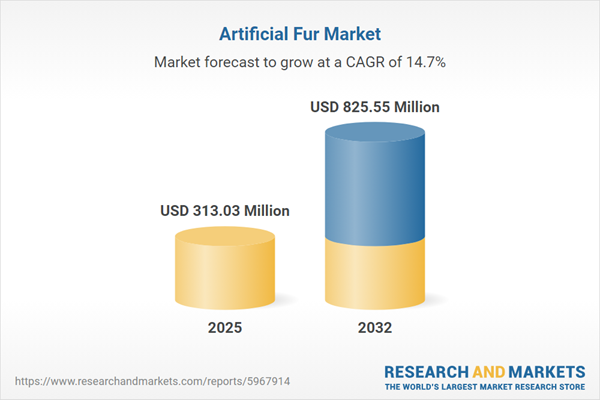Speak directly to the analyst to clarify any post sales queries you may have.
The artificial fur market is undergoing a significant transformation driven by sustainability imperatives, ethical sourcing, and the evolving demands of global industries. Decision-makers seeking actionable insights and growth strategies will find a comprehensive view of competitive trends, innovation, and emerging opportunities throughout the value chain.
Market Snapshot: Artificial Fur Market Size, Growth, and Outlook
The artificial fur market grew from USD 276.18 million in 2024 to USD 313.03 million in 2025 and is forecasted to reach USD 825.55 million by 2032, reflecting a compound annual growth rate (CAGR) of 14.66%. This expansion is catalyzed by improvements in synthetic fabric technology, consumer shifts toward sustainable luxury, and increasing adoption across fashion, home décor, and automotive interiors. The market’s robust growth trajectory highlights rising global investment and innovation in cruelty-free alternatives.
Scope & Segmentation
This report delivers a thorough analysis of the artificial fur industry, providing strategic segmentation and coverage across key market drivers and themes including:
- Pile Type: Long Pile, Medium Pile, Short Pile
- Material: Acrylic, Modacrylic, Polyester
- Type: Faux Fox, Faux Rabbit, Faux Shearling, Sheepskin, Sherpa
- Application: Apparel Industry, Automotive Industry, Home Decor
- Distribution Channel: Offline, Online
- Geography: Americas – United States, Canada, Mexico, Brazil, Argentina, Chile, Colombia, Peru; Europe, Middle East & Africa – United Kingdom, Germany, France, Russia, Italy, Spain, Netherlands, Sweden, Poland, Switzerland, United Arab Emirates, Saudi Arabia, Qatar, Turkey, Israel, South Africa, Nigeria, Egypt, Kenya; Asia-Pacific – China, India, Japan, Australia, South Korea, Indonesia, Thailand, Malaysia, Singapore, Taiwan
- Leading Companies: Adrienne Landau, Ambassador Textiles Ltd., ARORA KNITFAB PVT LTD, Big Z Fabric, BioFluff, Buttons & Beans Co., Changzhou Kingcason Printing & Dyeing Co., Ltd., Cixi Huakang Plush Co., Ltd., Dongjing Group, Fur-Textiles Nederland BV, ICE FABRICS, JAYLEY, Jiangsu Unitex Co., Ltd, Jiashan Yongbang Artificial Fur Co., Ltd., Nanjing Eastsun Textiles Co., Ltd., Nike, Inc., PELTEX FIBRES SARL, Ruili Textile Co., Ltd., Shanghai Ecopel Industrial Co., Ltd., Shannon Fabrics, Stoffhummel, The Throw Company, Tongxiang Zhuoyi Textiels Co., Ltd., Versatile Enterprises Pvt. Ltd., Wuxi Eco-Fur Fabric Technology Co., Ltd
Key Takeaways for Senior Decision-Makers
- Technological advances such as fiber engineering and digital printing are enabling artificial fur to closely mimic natural fur, supporting expanded use in premium segments.
- Increasing regulatory pressure and consumer advocacy are steering the industry toward transparent sourcing with blockchain solutions and third-party certifications.
- The direct-to-consumer model and digital buying experiences, including virtual product visualization, are reshaping retail and distribution strategies.
- Segment-specific demand highlights plush long-pile variants in luxury and automotive, with short and medium lengths supporting apparel versatility and lightweight design.
- Organizations leveraging collaborative R&D, particularly in sustainable feedstock and closed-loop manufacturing, are best positioned to meet evolving compliance and market expectations.
Tariff Impact: Navigating US Regulatory Changes
Recent tariffs imposed by the United States on select synthetic textiles and polymer feedstocks have triggered shifts in sourcing and cost structures across the artificial fur market. These measures are prompting manufacturers to optimize supplier portfolios, invest in nearshoring strategies, and pursue cost-effective trade routes. Forward-looking companies are also developing proprietary blends and value-engineered materials to secure preferential tariff consideration, sustaining competitiveness amid changing regulatory landscapes.
Methodology & Data Sources
Research for this report combines in-depth secondary analysis of trade publications, regulatory data, and proprietary databases with primary interviews from supply chain stakeholders. Structured interviews and coded qualitative insights ensure accurate validation of industry trends and strategic developments.
Why This Report Matters for Artificial Fur Market Stakeholders
- Enables informed, strategic planning by offering granular segmentation and actionable intelligence on emerging technologies, sustainability initiatives, and supply chain risk.
- Provides a competitive benchmarking tool for monitoring innovation, regional dynamics, and differentiation strategies among leading artificial fur manufacturers.
Conclusion
The artificial fur market presents dynamic growth potential paired with complex compliance and innovation requirements. Stakeholders equipped with actionable insights can make confident, future-ready decisions in response to shifting global and industry developments.
Additional Product Information:
- Purchase of this report includes 1 year online access with quarterly updates.
- This report can be updated on request. Please contact our Customer Experience team using the Ask a Question widget on our website.
Table of Contents
3. Executive Summary
4. Market Overview
7. Cumulative Impact of Artificial Intelligence 2025
Companies Mentioned
The companies profiled in this Artificial Fur market report include:- Adrienne Landau
- Ambassador Textiles Ltd.
- ARORA KNITFAB PVT LTD
- Big Z Fabric
- BioFluff
- Buttons & Beans Co.
- Changzhou Kingcason Printing & Dyeing Co., Ltd.
- Cixi Huakang Plush Co., Ltd.
- Dongjing Group
- Fur-Textiles Nederland BV
- ICE FABRICS
- JAYLEY
- Jiangsu Unitex Co., Ltd
- Jiashan Yongbang Artificial Fur Co., Ltd.
- Nanjing Eastsun Textiles Co., Ltd.
- Nike, Inc.
- PELTEX FIBRES SARL
- Ruili Textile Co., Ltd.
- Shanghai Ecopel Industrial Co., Ltd.
- Shannon Fabrics
- Stoffhummel
- The Throw Company
- Tongxiang Zhuoyi Textiels Co., Ltd.
- Versatile Enterprises Pvt. Ltd.
- Wuxi Eco-Fur Fabric Technology Co., Ltd
Table Information
| Report Attribute | Details |
|---|---|
| No. of Pages | 183 |
| Published | November 2025 |
| Forecast Period | 2025 - 2032 |
| Estimated Market Value ( USD | $ 313.03 Million |
| Forecasted Market Value ( USD | $ 825.55 Million |
| Compound Annual Growth Rate | 14.6% |
| Regions Covered | Global |
| No. of Companies Mentioned | 26 |









